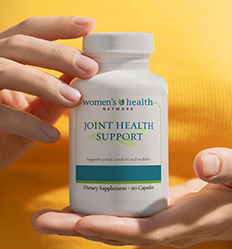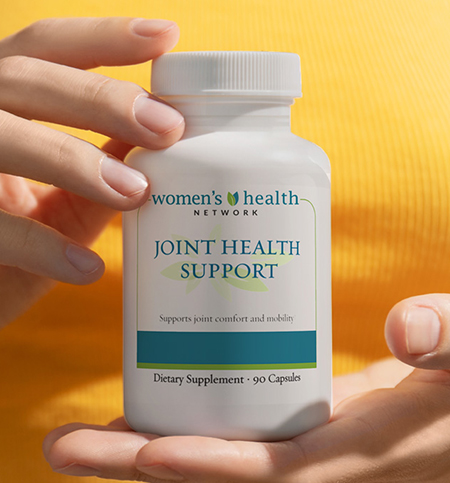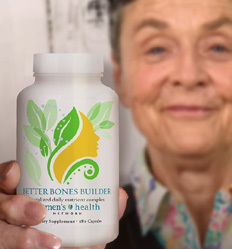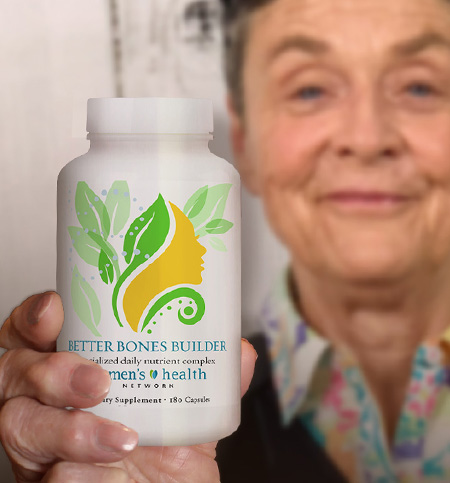Bone loss and joint pain might seem like completely separate issues, but the truth is they share a powerful link: chronic inflammation. Once you understand this connection, it can be the key to unlocking new ways to protect your bones, your joints — and your overall health and well-being! Read on for my simple steps to tame inflammation and why it matters for stronger bones and improved joint health.

Chronic inflammation does more harm than good – for both bones and joints
Inflammation is a natural positive response by your immune system to injury or infection. It’s a critical part of the body’s healing process by which damaged tissues are broken down, recycled and replaced with healthy new tissue. However, when the repair process falters, the tear-down inflammation stage becomes chronic, and this can do more harm than good, especially when it comes to your bones and joints.
How inflammation causes bone loss
Inflammation disrupts the balance between bone resorption (the breakdown of bone) and bone formation (the rebuilding of bone tissue). Normally, these two processes work in balance, but chronic inflammation tips the scales in favor of bone breakdown.
- Osteoclasts vs. Osteoblasts: Osteoclasts, the cells that break down bone, become more active during periods of chronic inflammation. At the same time, osteoblasts, the cells responsible for building new bone, become less effective. This imbalance leads to a gradual loss of bone density.
- Hormonal Impact: Inflammation also disrupts hormones that are crucial for bone health, especially during and after menopause. For example, estrogen plays a protective role in maintaining bone density, and when estrogen levels fluctuate (as they do during menopause), inflammation can further accelerate bone loss.
Inflammation not only weakens bones but also increases the risk of developing autoimmune conditions, such as rheumatoid arthritis, which further impacts both bone density and joint health.
How inflammation leads to joint pain
Just as inflammation can weaken bones, it also wreaks havoc on joint health and is a lead contributing factor to joint pain and stiffness.
- Cartilage Breakdown: Inflammation causes the breakdown of cartilage, the soft tissue that cushions joints and allows for smooth movement. Without enough cartilage, bones rub against each other, causing the pain, stiffness and limited mobility.
- Synovitis: In autoimmune conditions like rheumatoid arthritis, inflammation affects the lining of the joints (called the synovium). This leads to synovitis, which causes painful swelling, joint stiffness and further joint damage.
Whether it’s osteoarthritis or an autoimmune disease, chronic inflammation is the underlying factor that causes the destruction of joint tissue.
How does chronic inflammation develop? 5 key lifestyle + environmental factors
Several lifestyle and environmental factors contribute to chronic inflammation, leading to both bone loss and joint pain:
- Poor Diet: A diet high in processed foods, sugar, and unhealthy fats and alcohol can trigger inflammatory responses in the body. These foods are acidifying in the body and also increase cytokines, which are inflammatory molecules that worsen bone loss and joint pain.
- Lack of Exercise: A sedentary lifestyle allows inflammation to accumulate, reducing circulation and worsening joint stiffness and bone weakening.
- Chronic stress: The hormone cortisol, which is released in response to stress, can cause inflammation when consistently elevated. Long-term stress leads to higher inflammation, weakening bones and irritating joints.
- GI health issues: Poor gut health, especially conditions like leaky gut syndrome, allows harmful bacteria and toxins to enter the bloodstream, reducing nutrient absorption and triggering widespread inflammation. This systemic inflammation can affect both bone and joint health.
- Environmental toxins: Exposure to pollutants, chemicals and environmental toxins can cause your immune system to remain in a constant state of alert, exhausting anti-inflammatory nutrient stores and antioxidants. These deficiencies also add to the fire of chronic inflammation that affects your entire body, including your bones and joints.
Natural ways to combat inflammation and protect bone and joint health
Thankfully, there are many natural strategies to reduce inflammation and protect your bones and joints:
- Anti-Inflammatory Alkaline Diet: Give your diet a high antioxidant, alkalizing boost by focusing on whole, nutrient-dense foods that naturally reduce inflammation and promote overall health. Incorporate omega-3 fatty acids — found in foods like fatty fish (salmon, mackerel), walnuts, and flaxseeds — as these essential fats are known to lower inflammation in the body. Add an abundance of leafy greens (such as spinach, kale and arugula), along with antioxidant-rich berries and other colorful vegetables — all help combat oxidative stress, another driver of inflammation. Nuts and seeds provide a rich source of healthy fats, protein and vitamins that also fight inflammation.
At the same time, minimize your intake of processed foods, refined sugars and simple carbohydrates, which can spike blood sugar levels and trigger inflammatory responses. Shifting to an alkaline diet supports bone and joint health while keeping inflammation at bay.
- Exercise: Incorporating regular weight-bearing exercises (such as walking, weightlifting or resistance training) strengthens bones and helps prevent bone loss. Meanwhile, low-impact activities (swimming, cycling) help keep joints mobile and reduce stiffness without overloading them.
- Stress Management: Managing stress is crucial for reducing inflammation. Techniques like meditation, deep breathing, and yoga can help lower cortisol levels and reduce the inflammatory response in your body. Regular Tai Chi and Qi Gong are also helpful.
- Bone-Building + Joint Supporting Supplements: You want to give your body rich sources of nutrients that target your bone and joint concerns. For protecting your bones, our Better Bones Builder formula is a comprehensive daily supplement that provides your bones with all the vitamins, minerals, antioxidants and micronutrients needed to promote strong, flexible bones.
Inflammation is the silent force that connects bone loss and joint pain. By understanding how it impacts your bones and joints, you can take steps to reduce inflammation and improve your overall health. Simple lifestyle changes like eating an anti-inflammatory diet, staying active, managing stress and using targeted supplements can go a long way in protecting both your bones and joints.
Don’t wait for bone loss and joint pain to worsen — start addressing inflammation today for a healthier, pain-free future.













